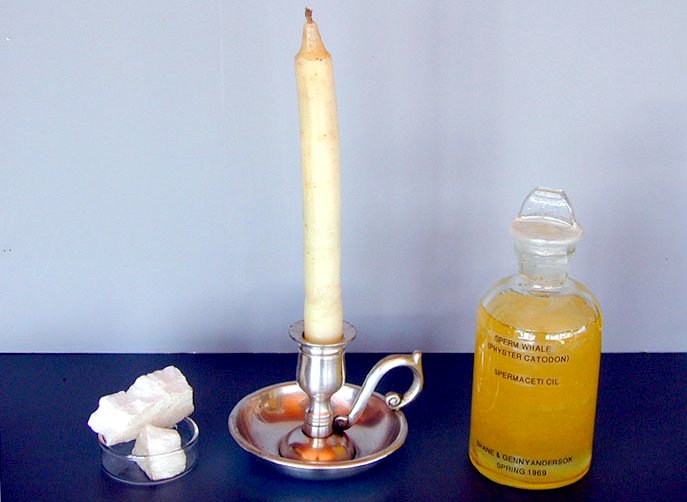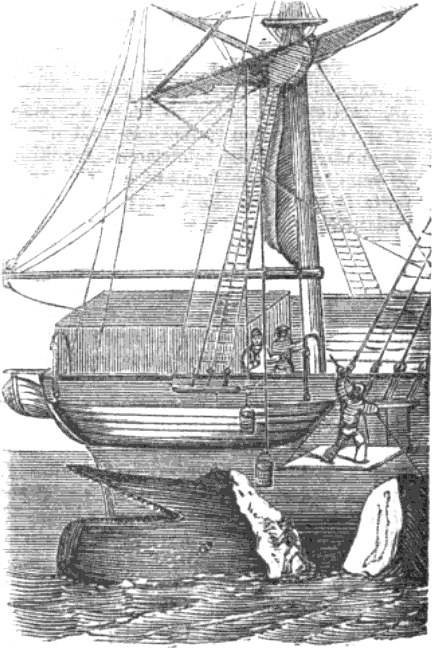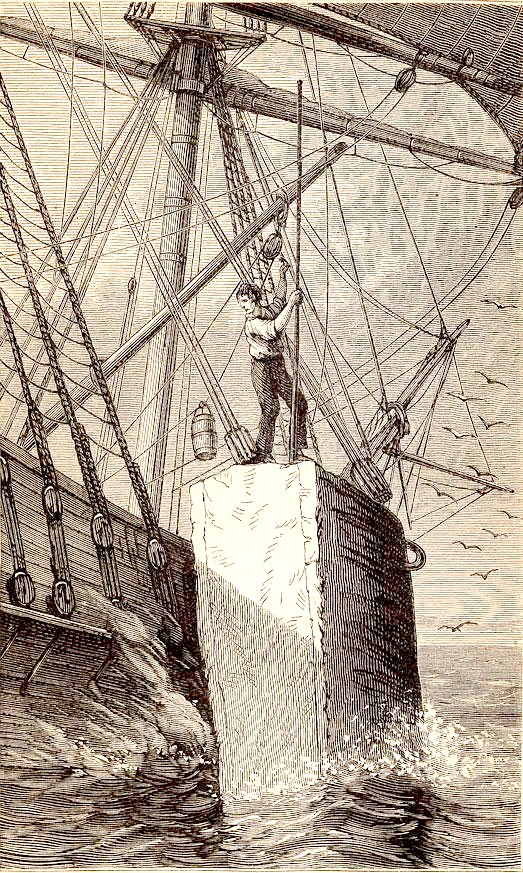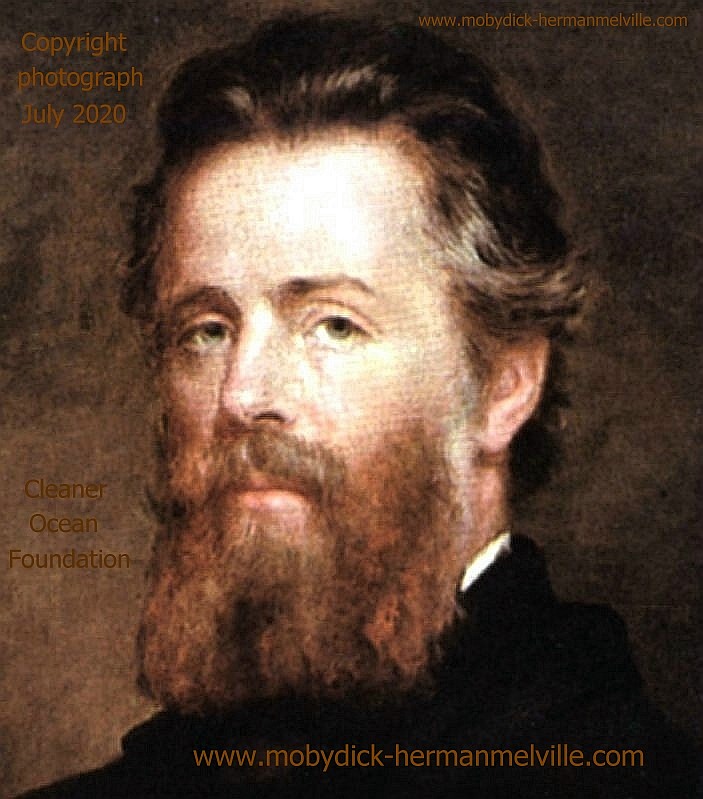
During the whaling era harvesters and manufacturers found spermaceti to be a
valuable chemical for making candles, cosmetics, ointments, textiles and various other materials due to its lack of smell or taste when congealed.
In order to prevent the spermaceti oil from going rancid the whalers would boil the wax to eliminate impurities and then cool it using a method known as wintering which involved the whalers and/or harvesters leaving the purified wax out in the cold until it cooled into a congealed state.
Spermaceti makes sperm
whales, $Billion
Dollar Whales. Because of the value of
these fabulous animals in chemical terms, they were almost hunted to
extinction, much the same as fisheries
have been overexploited until they ceased to exist.
The spermaceti that was found in the whale’s skull was originally believed to be semen as its pearly white wax like substance and coloring resembled that of actual sperm.
Because of its close resemblance to semen this whale’s oil producing organ and the waxy substance that came out of it were given the names “spermaceti organ” and “sperm oil” by those who hunted these marine mammals.
Eventually as technology became more advanced and scientists were better able to examine this pearly white wax like substance they realized that this chemical produced by the spermaceti organ isn’t sperm and plays no role in the whale’s reproductive system.

A
sperm whale carcass would be roped and chained to a ship, and a platform
lowered to enable the sailors to chop up the catch as quickly as
possible. It was hard work and dangerous with sharks competing for bites
of the dead animal.
Spermaceti is a waxy substance found in the head cavities of the
sperm whale (and, in smaller quantities, in the oils of other whales). Spermaceti is created in the spermaceti organ inside the whale's head. This organ may contain as much as 1,900 litres (500 US gal) of spermaceti.
The proportion of wax esters in the spermaceti organ increases with the age of the whale: 38–51% in calves, 58–87% in adult females, and 71–94% in adult males. Spermaceti wax is extracted from sperm oil by crystallisation at 6 °C (43 °F), when treated by pressure and a chemical solution of caustic alkali. Spermaceti forms brilliant white crystals that are hard but oily to the touch, and are devoid of taste or smell, making it very useful as an ingredient in
cosmetics, leatherworking, and lubricants. The substance was also used in making candles of a standard photometric value, in the dressing of fabrics, and as a pharmaceutical excipient, especially in cerates and ointments. Candlepower, a photometric unit defined in the United Kingdom Act of Parliament Metropolitan Gas Act 1860 and adopted at the International Electrotechnical Conference of 1883, was based on the light produced by a pure spermaceti candle.
Raw spermaceti is liquid within the head of the sperm whale, and is said to have a smell similar to raw milk. It is composed mostly of wax esters (chiefly cetyl palmitate) and a smaller proportion of triglycerides. Unlike other toothed whales, most of the carbon chains in the wax esters are relatively long (C10–C22). The
blubber oil of the whale is about 66% wax. When it cools to 30 °C or below, the waxes begin to solidify. The speed of sound in spermaceti is 2,684 m/s (at 40 kHz, 36 °C), making it nearly twice as good a conductor of sounds as the oil in a
dolphin's melon.

The
head of the sperm whale would be cut off and hoisted onboard ship, where
a hole would be cut to bucket out the oils.
WHALING
After killing a sperm whale, the whalers would pull the carcass alongside the ship, cut off the head and pull it on deck. Then, they would cut a hole in it and bail out the matter inside with a bucket. The harvested matter, raw spermaceti, was stored in casks to be processed back on land. A large whale could yield as much as 500 gallons.
The spermaceti was boiled and strained of impurities to prevent it from going rancid. On land, the casks were allowed to chill during the winter, causing the spermaceti to congeal into a spongy and viscous mass. The congealed matter was then loaded into wool sacks and placed in a press to squeeze out the liquid. This liquid was bottled and sold as "winter-strained sperm oil". This was the most valuable product: an oil that remained liquid in freezing winter temperatures.
Later, during the warmer seasons, the leftover solid was allowed to partially melt, and the liquid was strained off to leave a fully solid wax. This wax, brown in color, was then bleached and sold as "spermaceti wax". Spermaceti wax is white and translucent. It melts at about 50 °C (122 °F) and congeals at 45 °C (113 °F).
NEAR EXTINCTION
From the 18th to the mid-19th century, the whaling industry prospered. By some reports, nearly 50,000 whales, including sperm whales, were killed each year. Throughout the 1800s, "millions of whales were killed for their oil, whalebone, and ambergris" to fuel profits, and they soon became endangered as a species as a result. Due to studies showing that the whale populations were being threatened, the
International Whaling Commission instituted a moratorium on commercial whaling in 1982. Although ambergris is not harvested from whales, many countries also ban the trade of ambergris as part of the more general ban on the hunting and exploitation of whales.

Gregory
Peck gives an outstanding performance as Captain
Ahab, the obsessed
master of the Pequod, in the 1956
movie: Moby Dick.
A
BIT OF MOBY HISTORY
Moby
Dick is the story of a great white
sperm whale that fought back at
whalers who tried to harpoon him. The idea came to Herman Melville after
he spent time on a commercial whaler, where stories abounded of the
sinking of the Essex in 1821 and Mocha
Dick, a giant sperm whale that sank around 20 ships, before being
harpooned in 1838.
Moby
Dick has inspired a great many adaptations, the same basic story
finding its way into the making of four films and two television
adaptations.
In
addition there are many comics and illustrated volumes, adapted from the
original, one of which is the emerging graphic novel version of a large
humpback whale called Kulo Luna.
Kulo
Luna is not as big as the whales depicted in Herman
Melville's Moby
Dick, but she has a diamond encrusted heart of gold, only attacking
whaling ships that present a danger to herself or her friends. She
becomes a $Billion
Dollar Whale.

Herman
Melville was the author of what we'd now consider an illegal activity,
the commercial hunting of whales for oil and meat.
Please use our
A-Z INDEX to
navigate this site




